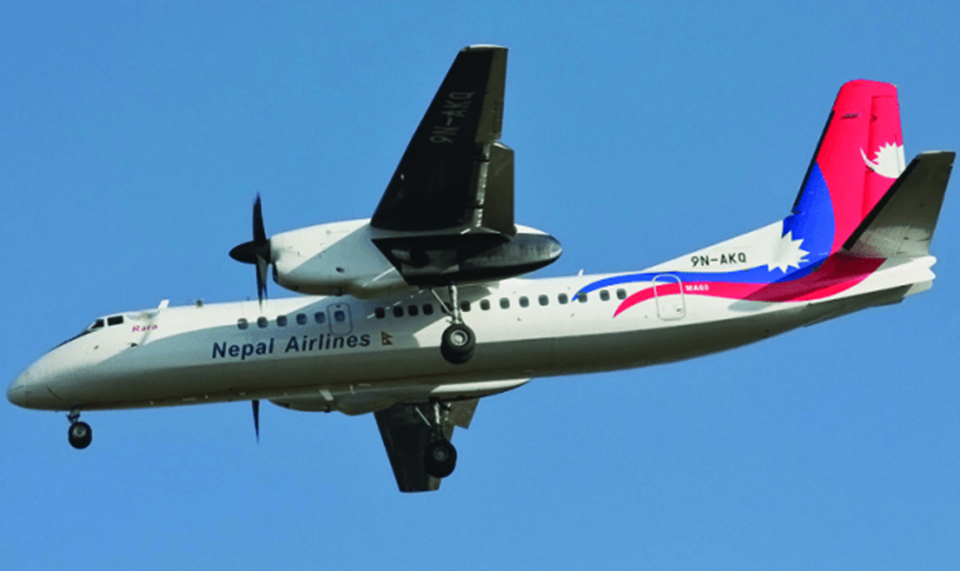
OR

Hopes of seeing RA’s domestic front invigorated has sadly turned sour
It is good that with the arrival of second A332 (9N-ALZ), RA’s fleet strength has risen to thirteen. But the bad news is eight of those in the domestic fleet either do very little or no flying at all. Chinese made aircraft like MA60s (Modern Ark 60) and Y12s are slowly nudging off the Twin-Otters whose number had been dwindling since long. But in spite of the new additions, hopes of seeing RA’s domestic front invigorated has sadly turned sour due to shortage of qualified pilots and spares. Qualified pilots are in big demand these days. India is facing problem hiring them even with 35 flying schools that churn out 400, of possible 1000 annually. We do not have even one training facility here. What an irony, we seem to be happy continue sending low-skilled workers elsewhere, as always, but compelled to rely on high-waged workers to do, literally, everything here including flying our planes.
It does not bode well for RA with only two (A320s) of the total (13), flying actively. The new widebody has just begun flying commercially. With a fleet of four (2/nb and 2/wb), not counting the B757, RA should be in a position to provide a modest level of service. But the question is how it manages the domestic front that has been in tatters for years?
While the Y-12 is not as capable as the Twin Otters it perhaps is the next best. It also happens to be the first Chinese aircraft to obtain type certificates from the US and UK. But our focus is on MA60 as our granting of Nepal type certificate has been the suspected reason for b-listing Nepal by European Aviation Safety Agency (EASA/EC). MA60 is a re-engineered version of An-24 (Antanov) but unlike the Russian breed, it comes with high power engines, better propeller and communication systems, all from branded world class companies of the West. The unresolved issue has brought in serious uncertainty factor to RA’s Europe dream. It has become a sort of a double whammy/setback for RA. To get the inside story this scribe tapped source with inside knowledge about this which is summarised as follows: MA60 had “Type Certificate” (TC) as issued by CAAC (China) but not from either FAA or EASA. This is a mandatory requirement before certificate of airworthiness is issued by Nepal. If not, the aircraft must have an additional Nepalese Type Certificate issued by the DG, CAAN as per prevailing Nepalese Civil Airworthiness Requirements (NCAR). To verify if the aircraft confirmed to the FAR Part 25 requirement a team was sent to China which on return reported positively. But during the audit by the EU team they found that TC issued by CAAN was not acceptable as it was done by people without necessary experience/expertise. And that is the crux of the whole issue behind b-listing.
Story of MA60
MA60 was initially ordered for Nepal Army. As cancelling was not possible, the government found it convenient to push these to unwilling RA. It has been in production since year 2000 and complies with China’s airworthiness certification which is, in effect, an exact copy of European/American standard. Xian has a long history of aircraft making and it even makes components for Boeing and Airbus. But with MA60 the Chinese product had its first encounter with high technological and regulatory hurdles. That aside, MA60 comes with a history of safety problems involving landing-gear malfunctions, braking failures, steering loss and several other mishaps. Finding them problematic some of its clients have switched to other makes.
MA60 has not applied for either American or European (FAA/EASA) certification as it does not aspire selling to high end market as yet. But the aircraft could still be useful to countries that are not rich enough and it is increasingly being marketed in such regions. RA’s experience has exposed the inherent weakness, on the part of the makers, in not being able to address issues promptly. Its dealings with few of its customers are reported to be laboriously slow, mainly due to poor communication accessibility and slow delivery of spares. Airlines naturally find this totally unacceptable.
Two options
The issue can temporarily be resolved if the either of the following options is considered. The first option naturally rests on Nepal Government (NG) and this includes getting MA60 removed from RA’s inventory. That would not be difficult as RA is wholly owned by NG. As it was intended for Nepal Army (NA) originally, the government could transfer it back to NA. But, on the other hand, it might be difficult as it may not be to NA’s liking, much like RA’s case before. As NA is seeking to sell its old air frames in order to get new ones, it is the right time to do this. As NA’s hardware is of no concern to EC, it may find it easier to remove Nepal from the b-list.
Secondly, existence of EASA safety oversight exceptions list reveals another new possibility. Such exceptions are seen to be made conditional to type of aircraft an airline can use for flights to EC countries, that is, “even if the country remains b-listed.” A total of six airlines (2 of Gabon / 1 each of N Korea, Comoros, Iran and Angola) are allowed to fly to Europe under this modality. EASA could do the same letting RA fly to Europe using only A330-243 by keeping the b-list intact. This would not only salvage EC’s ego but also save RA from the embarrassment of not being able to venture beyond the regional circuit after so much hype about having bought a European “widebody”.
If it was within its control, RA would cherry pick from both options. First, get MA60 off its back and then have EASA tweak it in along with other six already there. Lastly, CAAN has to ensure that officials deputed to perform such tasks should be qualified enough as this is the fundamental principle of audit.
harjyal@yahoo.com
You May Like This

Minister Sah calls for organic farming technology to double production
MAHOTTARI, May 15: Province no 2 Minister for Agriculture, Shailendra Sah, has called for tapping into the organic agricultural technology for... Read More...

Ronaldo double secures Real comeback win over Bayern
MUNICH, April 13: Cristiano Ronaldo became the first player to score 100 goals in UEFA competitions when he struck twice as... Read More...

Inflation still in double digits
KATHMANDU, June 17: Despite government's claims of having cracked its whip at price rises, the country's inflation is hovering at double... Read More...




Just In
- Health ministry to conduct ‘search and vaccinate’ campaign on May 13
- Indian customs releases trucks carrying Nepali tea, halted across Kakarbhitta
- Silent period for by-election to begin from midnight
- SC issues short-term interim order to govt and TU not to take immediate action against TU legal advisor Khanal
- National consultation workshop advocates to scale up nutrition smart community in Nepal
- Patan High Court issues short-term interim order to halt selection process of NTB’s CEO
- NEPSE inches up 0.15 points; daily turnover increases to Rs 2.53 billion
- Bagmati Govt mandates tri-lingual signboards in offices















Leave A Comment